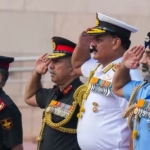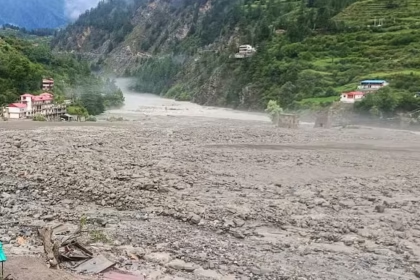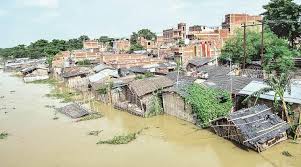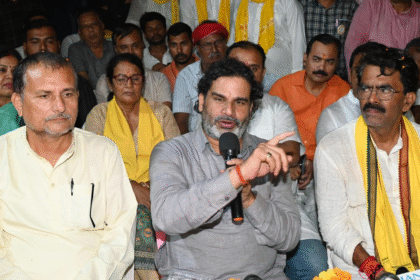Kargil Vijay Diwas: India Pays Tribute to Soldiers’ Unparalleled Courage and Sacrifice
The chill of July in the high-altitude passes of Kargil holds a haunting silence—broken only by the echoes of war, memory, and pride. Every year on July 26, that silence is broken by millions of voices across India who unite in reverence. Kargil Vijay Diwas is not just a commemoration of military success; it is a testament to unyielding courage, national unity, and the eternal spirit of sacrifice that binds the soul of this country.
This annual remembrance marks the day in 1999 when Indian armed forces successfully recaptured all infiltrated positions in the Kargil sector of Jammu and Kashmir. The operation, code-named Operation Vijay, came at a high cost: 527 Indian soldiers laid down their lives, and over 1,300 were wounded. But what they achieved resounds louder than the mountains they defended—it was a victory not just of land reclaimed, but of the nation’s collective spirit.
Genesis of a Conflict: When the Snow Hid the Enemy
To understand Kargil Vijay Diwas, one must revisit the cold betrayals that unfolded at over 16,000 feet. During the winter of 1998–99, Pakistani troops and militants—under the guise of Kashmiri insurgents—secretly crossed the Line of Control (LoC) and occupied strategic high-altitude ridges on the Indian side of Kargil. These locations overlooked vital Indian positions, including the National Highway 1D that links Srinagar to Leh, making it a strategic choke point.
By May 1999, Indian patrols discovered the infiltration. What began as skirmishes soon escalated into full-blown war. The Indian Army, braving extreme weather, treacherous terrain, and intense enemy fire, launched a series of operations to reclaim the heights. What followed was not just a battle for territory but a reaffirmation of India’s sovereignty.
Faces of Valor: Stories That Still Stir Hearts
Each name etched on the Kargil War Memorial in Dras tells a story—a son, a brother, a husband who chose duty above all. Captain Vikram Batra, remembered for his fearless war cry “Yeh Dil Maange More!”, became a household name. His actions during the capture of Point 5140 and later 4875, at the cost of his life, made him one of India’s most iconic war heroes.
Lieutenant Manoj Kumar Pandey, awarded the Param Vir Chakra posthumously, led his troops through heavy fire and grenade attacks, eventually laying down his life in an assault that secured a crucial enemy bunker. His last words, “Na chhodunga,” continue to inspire generations of soldiers and citizens alike.
The bravery extended beyond officers. Men like Grenadier Yogendra Singh Yadav, who scaled a vertical cliff face under enemy fire and continued fighting even after being shot multiple times, represent the undying spirit of the Indian jawan. His courage earned him the Param Vir Chakra while still alive—an honor few hold.
Beyond the Battlefield: A Nation Responds
Back home, the war ignited an overwhelming wave of nationalism. Citizens contributed funds, wrote letters, lit candles, and joined prayer vigils for the soldiers at the front. The war footage aired on Doordarshan and private news channels brought the frontlines into every living room. For the first time, the face of the Indian soldier—gritty, determined, humble—was etched deeply into the public consciousness.
Politically, the war led to renewed global attention on the Kashmir issue. India’s diplomatic efforts, especially then Prime Minister Atal Bihari Vajpayee’s firm yet measured stance, earned international support. Pakistan’s denial of involvement was refuted as India presented evidence of regular army involvement, including captured documents and prisoners of war.
Memorializing Sacrifice: The Symbol of Dras
Located at the foothills of Tololing, the Kargil War Memorial in Dras stands as a powerful reminder of what was achieved and what was lost. Built by the Indian Army, its sandstone walls carry the names of every soldier who fell during the conflict. The backdrop of barren peaks, once soaked in blood and fire, now watches over the Amar Jawan Jyoti—the eternal flame that honors the fallen.
Every year, top military commanders, political leaders, and family members of martyrs gather here on Kargil Vijay Diwas. The ceremony is a mix of somber reflection and proud celebration. Bugles sound, wreaths are laid, and soldiers march in synchronized reverence. It is not just the army that remembers—it’s the entire nation.
Passing the Torch: The Youth and the Kargil Legacy
Today’s generation, many of whom were not even born in 1999, continue to learn about the war through textbooks, documentaries, films like “LOC Kargil” and “Shershaah”, and now through immersive digital tributes. Schools and colleges observe Kargil Vijay Diwas by organizing essay competitions, remembrance events, and guest lectures by veterans. The effort is not merely to glorify war, but to instill the values of duty, integrity, and sacrifice.
Organizations like the Indian Army Veterans Association and several NGOs ensure that the stories of war heroes are preserved and shared. The rise of social media has also democratized remembrance. Hashtags like #KargilVijayDiwas, #RememberingOurHeroes, and #IndianArmy trend every year, flooded with tributes from common citizens.
A Day Etched in Blood and Pride
Kargil Vijay Diwas is not just a date in the calendar—it is a story of impossible odds, unimaginable bravery, and unbreakable spirit. It is a lesson in unity, resolve, and respect for those who stand between us and the enemy. As the tricolor flutters atop Tololing and Tiger Hill, it reminds us that freedom is neither cheap nor passive—it must be protected, often with lives.
The Indian Army’s victory in the 1999 Kargil War was not a result of spontaneous heroism alone—it was the product of calculated decisions, bold leadership, coordinated strikes, and strategic restraint. Behind every captured peak lay layers of planning, reconnaissance, logistical improvisation, and field-level execution under relentless pressure. Operation Vijay—India’s codename for the military response—became a textbook case of high-altitude warfare and tactical brilliance.
The Turning Point: From Reconnaissance to Realization
Initial reports of Pakistani infiltration came in early May 1999 when local shepherds noticed unusual movements in the higher ranges. When a patrol unit led by Captain Saurabh Kalia went missing in the Batalik sector and was later found tortured and killed in captivity, the gravity of the situation became undeniable. It was not a localized insurgency but a full-scale infiltration by Pakistan’s Northern Light Infantry and jihadist elements.
The initial Indian response was slow, cautious, and intelligence-driven. Reconnaissance flights by the Indian Air Force and satellite images confirmed the occupation of Indian peaks across a 160 km stretch. These posts provided the enemy a massive height advantage, enabling them to monitor Indian troop movements and fire with deadly accuracy.
The Tactical Puzzle: Fighting an Enemy Above
Unlike conventional warfare fought across plains, the Kargil conflict forced the Indian Army to attack uphill against entrenched enemies—a nearly impossible task under normal circumstances. The Pakistanis, perched atop ridgelines and camouflaged within fortified bunkers, had a distinct tactical advantage.
Indian troops had to scale steep, icy cliffs—often at night and under heavy shelling—while carrying equipment and weapons, without aerial cover in the initial phases. Most of the battles occurred at altitudes between 16,000 and 18,000 feet, where oxygen is scarce, fatigue is rapid, and survival itself is a challenge.
What tipped the balance in India’s favor was coordinated ground assault plans, local knowledge, and real-time battlefield intelligence.
Air Power Unleashed: Operation Safed Sagar
Parallel to Operation Vijay, the Indian Air Force launched Operation Safed Sagar on May 26, 1999—its first large-scale operation in the region since 1971. The mission’s objective was to support ground forces by bombing enemy positions, providing logistical support, and disrupting supply lines.
MiG-21s, MiG-27s, and Mirage-2000 jets were deployed with precision-guided munitions. The Mirage-2000 became a game-changer, executing successful bombing raids on enemy supply bases and communication hubs. On June 24, a landmark strike on the Tiger Hill complex severely weakened Pakistan’s defense, allowing Indian ground forces to eventually reclaim it.
The Indian Air Force, however, operated under strict rules of engagement—it was prohibited from crossing the Line of Control, a decision that reinforced India’s diplomatic stance and maintained the conflict’s limited-war framework.
Leadership on the Frontlines
The leadership at multiple levels—political, military, and strategic—played a vital role in the eventual victory.
- Prime Minister Atal Bihari Vajpayee maintained a firm international position, refusing to escalate the conflict into a full-blown war and exposing Pakistan’s aggression to the world.
- General Ved Prakash Malik, then Chief of Army Staff, made the critical decision to mobilize over 200,000 troops to the front despite initial shortages in resources. His leadership ensured coordination among battalions across sectors like Dras, Kargil, Batalik, and Mushkoh Valley.
- Field commanders like Brigadier M.P.S. Bajwa, who led the recapture of Tololing, and Colonel Ravindranath, who led the assault on Tiger Hill, displayed exceptional tactical insight.
Most importantly, junior leadership—company commanders, lieutenants, and captains—demonstrated unmatched initiative and bravery, often making split-second decisions in deadly situations.
Peak by Peak: Key Battles That Defined the War
Each strategic victory during Operation Vijay came at a tremendous cost. The capture of major peaks involved complex maneuvers, casualties, and overnight advances in freezing temperatures.
- Tololing (June 13, 1999): The first major breakthrough. Indian troops launched several unsuccessful attempts before finally dislodging the enemy in a daring night assault.
- Point 5140 (June 20, 1999): Led by Captain Vikram Batra, the capture of this point opened up routes to other strategic positions. His famous message, “Yeh Dil Maange More,” became symbolic of the Indian soldier’s grit.
- Tiger Hill (July 4, 1999): A heavily fortified peak that took over a week of battle to conquer. Soldiers climbed vertical cliffs at night and launched a surprise attack at dawn. Its fall demoralized the enemy and marked a turning point in the conflict.
- Point 4875 (July 7, 1999): Also known as Batra Top, it was where Captain Batra fell during the final assault. Its recapture gave India full control over the Mushkoh Valley.
By July 14, the Indian Army declared the mission nearly complete, and by July 26, all high-altitude positions had been recaptured.
Logistical Triumph: Fighting the Terrain and the Clock
The Kargil War tested not only courage but also India’s military logistics. Supplying thousands of soldiers with food, ammunition, medical supplies, and communication equipment in rugged terrain required extraordinary coordination.
Helicopters from the Indian Air Force and Army Aviation Corps played a critical role in airdropping rations, evacuating wounded soldiers, and transporting weapons. The BRO (Border Roads Organisation) worked round the clock to keep supply routes open under constant shelling.
Despite international concerns and domestic pressure, the Indian Army showed remarkable restraint, professionalism, and discipline—choosing surgical ground offensives over indiscriminate retaliation.
Diplomacy and Denial: Pakistan’s Global Isolation
As Indian forces advanced, Pakistan’s narrative collapsed under global scrutiny. The Nawaz Sharif government initially denied any involvement, blaming “Kashmiri freedom fighters.” However, captured documents, dead soldiers with Pakistani ID cards, and intercepted communications exposed the direct involvement of Pakistan’s military.
Facing pressure from the United States, G8, and the United Nations, Pakistan was forced to withdraw its remaining troops. On July 4, 1999, Prime Minister Sharif flew to Washington to meet President Bill Clinton, who firmly asked Pakistan to retreat unconditionally. India, meanwhile, emerged diplomatically vindicated.
Victory Earned, Not Gifted
Operation Vijay stands as a rare military campaign where India maintained moral high ground while achieving military success. It demonstrated that even the most treacherous terrain can be conquered through unity, intelligence, and courage. Every peak reclaimed was a blow to deception and a triumph of national pride.
While the battle ended in July 1999, the lessons of leadership, logistical resilience, and strategic planning continue to guide India’s armed forces.
Victory in war may be marked by reclaimed territory and tricolours hoisted on conquered peaks, but its true cost is borne silently by families who never see their loved ones return. While India celebrates Kargil Vijay Diwas with pride, it also serves as a solemn reminder of the grief that lingers in thousands of homes across the country. Behind every name inscribed on the Kargil War Memorial is a mother who lost her son, a child who grew up without a father, a wife left in mourning, and a nation that owes a debt it can never fully repay.
The Final Letter Home: Words That Still Echo
One of the most heart-wrenching facets of the Kargil conflict was the letters written by soldiers shortly before their deaths. Many of these have since surfaced—treasured by families, archived by regiments, or made public in tribute documentaries.
A letter from Captain Vijayant Thapar, written days before he fell in battle, begins with the words: “By the time you get this letter, I will be observing you all from the sky.” His parting words to his family asked them not to grieve but to be proud. That single letter now sits framed in his family home—an eternal flame of both sorrow and pride.
These letters and last phone calls, though brief, have become the emotional legacy of the war. They serve as reminders that soldiers are not just warriors—they are sons, brothers, husbands, and fathers who made the ultimate choice knowing full well what it could cost.
The Pain That Time Cannot Erase
For many families of the fallen, the news came in the most abrupt and heartbreaking manner. A knock on the door. A telegram. An officer standing silently with folded hands. For others, it was the national broadcast, or a friend in uniform sent to deliver the unthinkable.
In some cases, especially in the initial stages of the war, families held out hope for weeks—until official confirmation arrived. Several soldiers had gone missing in action, and identification took time due to the remoteness of the conflict zones.
- Veer Nari (War Widow) communities saw a surge in membership. These women, some only in their twenties, had to rebuild their lives, often with young children in tow.
- Parents from humble rural backgrounds became overnight symbols of national resilience. Though shattered by grief, they appeared in public with calm dignity, reminding the nation to honour the sacrifice, not just mourn it.
Honours and Memorials: Gratitude Beyond the Medal
India’s government and armed forces ensured that gallantry was formally recognized. Many of the Kargil heroes received Param Vir Chakra, Maha Vir Chakra, and Vir Chakra medals, either during the war or posthumously.
But more than medals, what comforted families was the public remembrance and national acknowledgment:
- Roads, parks, schools, and stadiums were renamed after fallen soldiers.
- Statues and busts were erected in towns and cities.
- Their life stories began to be taught in schools, and their families were invited to address gatherings, inspiring youth across generations.
In Palampur, Himachal Pradesh, a stadium was named after Captain Vikram Batra. In Uttar Pradesh, the village of Lieutenant Manoj Kumar Pandey was transformed into a memorial site that sees visitors every Vijay Diwas.
Life After Loss: Mothers, Fathers, Wives, Children
Behind every war hero is a family that lives through the trauma for a lifetime.
- Mothers, like the late Kamla Devi (mother of Capt. Batra), became active voices in military welfare circles, attending events, mentoring young cadets, and supporting other grieving families.
- Wives, like Dimple Cheema, fiancée of Capt. Batra, remained devoted to the memory of their partners—her story gained renewed attention through the film Shershaah, where her decision to remain unmarried as a mark of love moved millions.
- Children, some born after their fathers’ deaths, grew up shaped by the legacy of sacrifice. Many have joined the military themselves, continuing the lineage of service.
These personal journeys are marked by resilience and dignity. While government schemes, pensions, and land allocations helped, the emotional wound never healed. The families often say, “We gave our everything. Let the country remember that every day.”
Support Systems and Shortcomings
Post-Kargil, India’s defense and welfare mechanisms saw some restructuring. The war exposed gaps in how families of the fallen were supported.
While initial compensation was quick, long-term rehabilitation and psychological support were often missing:
- The lack of dedicated grief counseling for widows and parents became a point of concern.
- Bureaucratic delays in allotting promised land or employment for dependents were frequently reported.
To address this, the government created schemes like:
- Army Welfare Housing Organization (AWHO)
- Ex-Servicemen Contributory Health Scheme (ECHS)
- Kendriya Sainik Board (KSB)
NGOs such as War Widows Association and Veer Nari Shakti Resettlement Foundation also stepped in to bridge the emotional and logistical gaps left by state systems.
Public Memory and the Role of Media
Indian media played a pivotal role during and after the Kargil conflict. The human face of war was brought to the fore, with journalists like Barkha Dutt reporting live from bunkers and war zones.
What followed was a surge in public empathy and involvement. Citizens wrote letters to soldiers, gathered donations for war memorial funds, and even volunteered time and effort for rehabilitation programs.
Over the years, films and documentaries helped preserve the stories:
- LOC: Kargil (2003) by J.P. Dutta depicted multiple heroes and battles.
- Shershaah (2021), based on Captain Vikram Batra, reached a global audience and ignited fresh interest in war history.
- TV shows, newspaper columns, and YouTube channels continue to publish testimonials, family interviews, and rare footage.
Yet, many argue that public memory fades quickly after each Vijay Diwas. Families of martyrs still seek consistent year-round support, not just symbolic gestures once a year.
The Real Question: Was It All Worth It?
For the families, this is a question that haunts quietly but powerfully. The resounding answer is often not one of bitterness, but of hope:
“Yes, if it meant the country is safer. Yes, if it inspired the next generation to serve. But let the sacrifice not be forgotten. That’s all we ask.”
The Grief That Made the Nation Stronger
Kargil was won not only on the mountains of Dras and Batalik but also in the homes of ordinary Indians who lost everything. The human cost of that victory continues to echo in temples, school classrooms, army mess halls, and the national conscience. We must never forget that while the tricolor flew high after July 26, 1999—it was stained with the blood of those who will never see it wave again.
Also Read : Only a Massive Virat Kohli Slump Can Stop Joe Root from Breaking Sachin Tendulkar’s 15,921-Run Test Record








